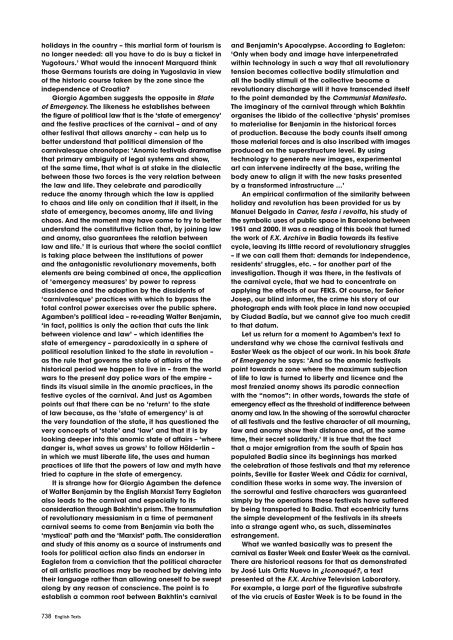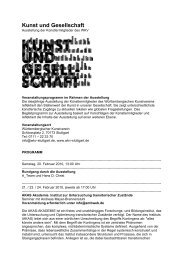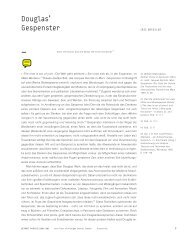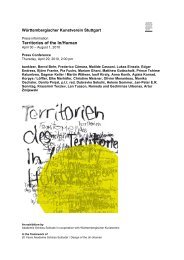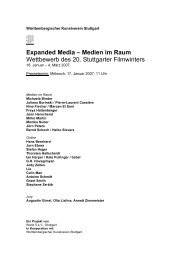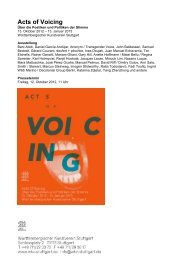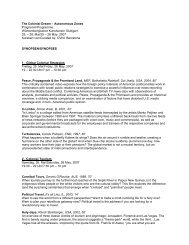English Texts
English Texts
English Texts
Create successful ePaper yourself
Turn your PDF publications into a flip-book with our unique Google optimized e-Paper software.
holidays in the country – this martial form of tourism is<br />
no longer needed: all you have to do is buy a ticket in<br />
Yugotours.’ What would the innocent Marquard think<br />
those Germans tourists are doing in Yugoslavia in view<br />
of the historic course taken by the zone since the<br />
independence of Croatia?<br />
Giorgio Agamben suggests the opposite in State<br />
of Emergency. The likeness he establishes between<br />
the figure of political law that is the ‘state of emergency’<br />
and the festive practices of the carnival – and of any<br />
other festival that allows anarchy – can help us to<br />
better understand that political dimension of the<br />
carnivalesque chronotope: ‘Anomic festivals dramatise<br />
that primary ambiguity of legal systems and show,<br />
at the same time, that what is at stake in the dialectic<br />
between those two forces is the very relation between<br />
the law and life. They celebrate and parodically<br />
reduce the anomy through which the law is applied<br />
to chaos and life only on condition that it itself, in the<br />
state of emergency, becomes anomy, life and living<br />
chaos. And the moment may have come to try to better<br />
understand the constitutive fiction that, by joining law<br />
and anomy, also guarantees the relation between<br />
law and life.’ It is curious that where the social conflict<br />
is taking place between the institutions of power<br />
and the antagonistic revolutionary movements, both<br />
elements are being combined at once, the application<br />
of ‘emergency measures’ by power to repress<br />
dissidence and the adoption by the dissidents of<br />
‘carnivalesque’ practices with which to bypass the<br />
total control power exercises over the public sphere.<br />
Agamben’s political idea – re-reading Walter Benjamin,<br />
‘in fact, politics is only the action that cuts the link<br />
between violence and law’ – which identifies the<br />
state of emergency – paradoxically in a sphere of<br />
political resolution linked to the state in revolution –<br />
as the rule that governs the state of affairs of the<br />
historical period we happen to live in – from the world<br />
wars to the present day police wars of the empire –<br />
finds its visual simile in the anomic practices, in the<br />
festive cycles of the carnival. And just as Agamben<br />
points out that there can be no ‘return’ to the state<br />
of law because, as the ‘state of emergency’ is at<br />
the very foundation of the state, it has questioned the<br />
very concepts of ‘state’ and ‘law’ and that it is by<br />
looking deeper into this anomic state of affairs – ‘where<br />
danger is, what saves us grows’ to follow Hölderlin –<br />
in which we must liberate life, the uses and human<br />
practices of life that the powers of law and myth have<br />
tried to capture in the state of emergency.<br />
It is strange how for Giorgio Agamben the defence<br />
of Walter Benjamin by the <strong>English</strong> Marxist Terry Eagleton<br />
also leads to the carnival and especially to its<br />
consideration through Bakhtin’s prism. The transmutation<br />
of revolutionary messianism in a time of permanent<br />
carnival seems to come from Benjamin via both the<br />
‘mystical’ path and the ‘Marxist’ path. The consideration<br />
and study of this anomy as a source of instruments and<br />
tools for political action also finds an endorser in<br />
Eagleton from a conviction that the political character<br />
of all artistic practices may be reached by delving into<br />
their language rather than allowing oneself to be swept<br />
along by any reason of conscience. The point is to<br />
establish a common root between Bakhtin’s carnival<br />
and Benjamin’s Apocalypse. According to Eagleton:<br />
‘Only when body and image have interpenetrated<br />
within technology in such a way that all revolutionary<br />
tension becomes collective bodily stimulation and<br />
all the bodily stimuli of the collective become a<br />
revolutionary discharge will it have transcended itself<br />
to the point demanded by the Communist Manifesto.<br />
The imaginary of the carnival through which Bakhtin<br />
organises the libido of the collective ‘physis’ promises<br />
to materialise for Benjamin in the historical forces<br />
of production. Because the body counts itself among<br />
those material forces and is also inscribed with images<br />
produced on the superstructure level. By using<br />
technology to generate new images, experimental<br />
art can intervene indirectly at the base, writing the<br />
body anew to align it with the new tasks presented<br />
by a transformed infrastructure …’<br />
An empirical confirmation of the similarity between<br />
holiday and revolution has been provided for us by<br />
Manuel Delgado in Carrer, festa i revolta, his study of<br />
the symbolic uses of public space in Barcelona between<br />
1951 and 2000. It was a reading of this book that turned<br />
the work of F.X. Archive in Badia towards its festive<br />
cycle, leaving its little record of revolutionary struggles<br />
– if we can call them that: demands for independence,<br />
residents’ struggles, etc. – for another part of the<br />
investigation. Though it was there, in the festivals of<br />
the carnival cycle, that we had to concentrate on<br />
applying the effects of our FEKS. Of course, for Señor<br />
Josep, our blind informer, the crime his story of our<br />
photograph ends with took place in land now occupied<br />
by Ciudad Badía, but we cannot give too much credit<br />
to that datum.<br />
Let us return for a moment to Agamben’s text to<br />
understand why we chose the carnival festivals and<br />
Easter Week as the object of our work. In his book State<br />
of Emergency he says: ‘And so the anomic festivals<br />
point towards a zone where the maximum subjection<br />
of life to law is turned to liberty and licence and the<br />
most frenzied anomy shows its parodic connection<br />
with the “nomos”: in other words, towards the state of<br />
emergency effect as the threshold of indifference between<br />
anomy and law. In the showing of the sorrowful character<br />
of all festivals and the festive character of all mourning,<br />
law and anomy show their distance and, at the same<br />
time, their secret solidarity.’ It is true that the fact<br />
that a major emigration from the south of Spain has<br />
populated Badia since its beginnings has marked<br />
the celebration of those festivals and that my reference<br />
points, Seville for Easter Week and Cádiz for carnival,<br />
condition these works in some way. The inversion of<br />
the sorrowful and festive characters was guaranteed<br />
simply by the operations these festivals have suffered<br />
by being transported to Badia. That eccentricity turns<br />
the simple development of the festivals in its streets<br />
into a strange agent who, as such, disseminates<br />
estrangement.<br />
What we wanted basically was to present the<br />
carnival as Easter Week and Easter Week as the carnival.<br />
There are historical reasons for that as demonstrated<br />
by José Luis Ortiz Nuevo in ¿Iconoqué?, a text<br />
presented at the F.X. Archive Television Laboratory.<br />
For example, a large part of the figurative substrate<br />
of the via crucis of Easter Week is to be found in the<br />
738 <strong>English</strong> <strong>Texts</strong>


